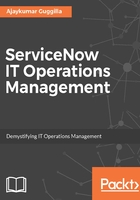
Cloud management
In the earlier versions prior to ServiceNow, there was no direct way to manage cloud instances, people had to create orchestration scripts to manage the cloud instances and also create custom roles.
Managing and provisioning has become easy with the ServiceNow cloud management application. The cloud management application seamlessly integrates with the ServiceNow service catalog. A Service Catalog provides a catalogs of services offered by an organization which has workflows built in with automation capability using orchestration workflows. The cloud management application fully integrates the life cycle management of virtual resources into standard ServiceNow data collection, management, analytics, and reporting capabilities.
The ServiceNow cloud management application provides easy and quick options to key private cloud providers, which include:
- AWS Cloud: Manages Amazon Web Services (AWS) using AWS Cloud
- Microsoft Azure Cloud: The Microsoft Azure Cloud application integrates with Azure through the service catalog and provides the ability to manage virtual resources easily
- VMware Cloud: The VMware Cloud application integrates with VMware vCenter to manage virtual resources by integrating with the service catalog
The following figure describes a high-level architecture of the cloud management application:

Key features with the cloud management applications include the following:
- A single pane of glass to manage the virtual services in public and private cloud environment including approvals, notifications, security, asset management, and so on
- The ability to repurpose configurations through resource templates that help to reuse the capability sets
- Seamless integration with the service catalog, with a defined workflow and approvals integration, can be done end to end right from the user request to the cloud provisioning
- The ability to control the leased resources through date controls and role-based security access
- The ability to use the ServiceNow discovery application to discover the infrastructure components or the standalone capability to discover virtual resources and their relationships in their environments
- The ability to control and manage virtual resources effectively with a controlled termination shutdown date
- The ability to perform a price calculation and integration of managed virtual machines with asset management
- The ability to automatically or manually provision the required cloud environment with zero click options
There are different roles within the cloud management applications, here are some of them:
- Virtual provisioning cloud administrator: The administrator owns the cloud admin portal and end-to-end management including configuration of the cloud providers. They have access to be able to configure the service catalog items that will be used by the requesters and the approvals required to provision the cloud environment.
- Virtual provisioning cloud approver: Who either approves or rejects requests for virtual resources.
- Virtual provisioning cloud operator: The operator fulfills the requests to manage the virtual resources and the respective cloud management providers. Cloud operators are mostly involved when a manual human intervention is required to manage or provision the virtual resources.
- Virtual provisioning cloud user: Users have access to the my virtual assets portal that helps them to manage the virtual resources they own, have requested, or are responsible for.
